
skchai
-
Posts
1,038 -
Joined
-
Last visited
Content Type
Profiles
Forums
Store
Help Articles
Posts posted by skchai
-
-
Chris - San Jose's got some great pho places, so maybe they'll find room for it at SJSU one of these days! I wonder about the pho-to-go myself. One issue is that they've got to find a way so that you can separate the rare meat so that it doesn't overcook while you're carrying it around. Other than that, I think it would be a great idea - what better way to satisfy the midnight munchies on a cold night than a bowl of pho?
Laniloa, welcome to the Hawai`i forum, hope to hear more from you! The Ba-Le in Maryland sounds intriguing. Either they have some sort of unofficial franchise or they know how to copy real well. Either way, the Ba-Le idea and name keeps on growing. . . .
-
Reid - mahalos for the clarification on Beard Papa. So they were one of those temporary displays! But given how crazy people went over them, let's hope they'll decide to locate here permanently.
PPC - you're right - the fact that the food is cooked to order is very un-bentoish. The main reason I classified Well Bento as a bento is because, well, they call themselves that! But the presentation is really plate-lunch like. The question is, which is higher on the evolutionary scale?
-
Tad, Joan, Muffin - Hey, I wish I could make it - I'll be in LA with my family in a couple of weeks - a bit late- that's just the kind of place I'd like to visit. Hopefully if you all have time the same crew can get together while we're there.
-
Anyplace in the "tandoor-loin" in SF. They are pretty much all Pakistani-owned. Strict Punjabi non-veg "dhaaba"-style. Shalimar (already mentioned) and Naan n' Curry are the best known but I liked Lahore Karahi the best. Hard to spend more than $10 even if you stuff your face.
-
I'm going to be be in Monterey Park in a couple weeks, so I was wondering the same thing. Would especially like to know people's picks in fairly usual restaurant categories, e.g. Muslim, Hakka, Shandong etc. that you can't get in most cities.
I ordered the book Finding Chinese Food in Los Angeles: A Guide to Regional Chinese Cuisines by Carl Chu, which I've heard a lot of good things about. It is a couple years out of date, but apparently has a lot of background material that your ordinary restaurant guides lack. He also has put out more recent, conventional, guide to Chinese restaurants in LA as well as NY and SF.
-
Thanks for the colorful report and personal recollections, Larry. . .
Raquel - good places for sundubu tchigae in Los Angeles! That's like asking if there are good places for coal in Newcastle. Or Spam in Hawai`i. Just kidding. I realize that not all the places around there are good. However (LA denizens please correct me if I'm wrong - that means you Joan!), the most famous LA sundubu restaurant (and now chain) is Bukchangdong Sundubu (BCD). The original is on 3575 Wilshire Blvd. in K-town, Tel 213 382-6677. It seems to kind of originated the rice n' peas accompaniment that a lot of sundubu places now copy. My family is going to be in LA in a couple of weeks, so I'm sure we're going to check out at least one of the BCDs.
Interestingly enough, in the last couple years there has appeared a very large chain of sundubu places in South Korea (with branches even in Nagoya, Japan) called LA Bukchangdong Sundubu (BSD). As far as I can tell there is no formal relationshp between it and BCD in the United States; it may be just another case of the wonderful disregard for trademark ownership in South Korea, though I'm not sure.
Even more strangely, since the former SGD Sundubu in Hawai`I has moved to more spacious quarters, its old space has been occupied by another place called Bukchangdong Soft Tofu. That's the place you probably ate at, Larry. As far as I know, it has nothing with either BCD in LA or BSD in Korea. Someone has to get to the bottom of this, though probably not me. . .
By the way, in case anyone is interested, Sogongdong and Bukchangdong are both districts in Seoul that border Namdaemun (the giant gate that used to mark the southern boundary of the city). And yes, both places have a lot of sundubu restaurants.
-
Thanks, you guys. The towers (I'm not sure what the exact name is either) come from a 60th birthday display; the index page for them is labeled "hwaegap food". They are not usually on pedastals like that - look strangely like kahili (Hawaiian royal feather standards).
As the others have mentioned, the dried fruit ones are kkotgam - dried persimmons, with pine nuts stuck into them for decorative (?) effect. The others are dashik - festive sweetened lumps made from bean and other flours, sort of like eating huge Tums tablets. Consulting a tteok and hangwa (Korean sweets) cookbook I can try to guess the specific types - the black ones are black sesame, the brown ones soybean, the yellow ones mung bean, the pink ones mung bean + omija (maximowiczia typica - not that that helps much - a kind of fragrant, tart berry often used for flavoring and coloring), and the white ones songhwa (not sure = pinecone?).
Taking the bottom row on the index page, the kahili from left to right appear to be: simpler dashik, dried persimmons, daechu (jujube - natsume in Japanese), raw peeled chestnuts (I think), more complicated dashik, and yakgwa (Korean fried cookies). The yakgwa in the picture are really soft and syrupy looking compared to the sinkers you find in the stores - the way it's arranged, doesn't it kind of remind you (weirdly enough) of croquembouche?
-
O.K., forget about the local-style bentos for now. Here are a couple of fringe bentos for those who have had enough of teri-spam and katsu-ume:
Well Bento
2570 S. Beretania St. 204
Honolulu HI 96826
808 941-5261

How about a vegan bento? There is such a thing at Well Bento in the middle of the "health food triangle" surrounded by University, Beretania, and King Streets. This place specializes in alternative bento offerings, some vegetarian and all, I believe, non-dairy. The flame grilled tempeh (fermented crushed soybean blocks) number above is served with a not-too-sweet tamari (soy sauce with no wheat) teriyaki. Underneath the big pile of tempeh is a very small amount (by local standards) of brown rice. The carrots and potatoes are freshly grilled along with the tempeh, so you need to wait at least 10 minutes for your bento to be ready, unless you are so together to have phoned your order. Both the mac salad and cole slaw are prepared with a special house-made "mayonnaise" that contains pureed tofu.
Besides tempeh, you can get as your main dish a choice of seitan (wheat gluten), tofu, as well as a variety of transitionals such as chicken, salmon, and flank steak. So I guess if you are a real macrobiotic purist you wouldn't feel safe. In fact, the nonveg dishes are among the most popular among the lunchtime crowd. Each entrée is prepared with a choice of tamari teriyaki sauce, "Cajun" spices, or maple barbecue sauce. The sides are all the same regardless. Besides the mix-and-match, there are usually a few specials, which I haven't had a chance to try. . .
Shirokiya
1450 Ala Moana Blvd. 2250 (Ala Moana Center)
Honolulu HI 96814
808 973-9111
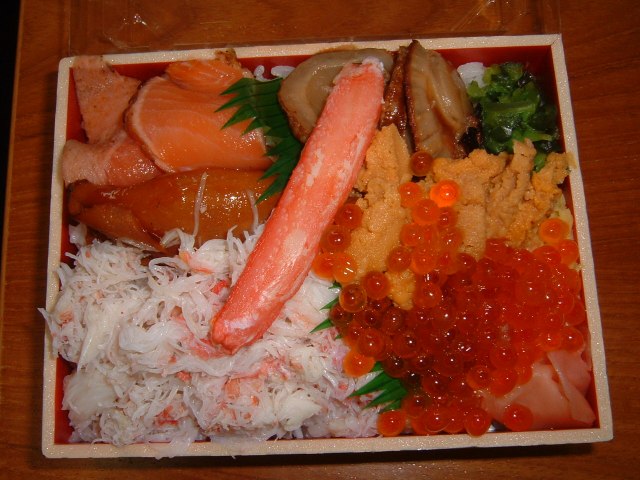
How about a luxury bento (relatively speaking, at $14.95) from Shirokiya's upper floor food court?
Shirokiya's Ala Moana store is the sole remaining branch anywhere of what was Japan's first department store. It's a long story - skip to the next paragraph if you don't want to know. Shirokiya was an Edo-period supplier of kimonos and textiles, founded in 1662, which transformed itself into a department store in the early part of the 20th century. The deadly fire at the original Nihonbashi branch of the department store in 1932 was one of the defining events in the history of modern Tokyo, and is deemed responsible, bizarrely enough, for first widespread use of underwear in Japan. It was widely publicized in the newspapers of the time that the deaths in the fire were caused by the fact that women dressed in kimono refused to slide down safety ropes with two hands because they were afraid to expose themselves. Shirokiya was bought up in 1958 by the Tokyu conglomerate, who transformed the Japan branches into Tokyu Department Stores, while leaving the Shirokiya name operating in Honolulu. The Honolulu Shirokiya was sold a few years ago Tokyu to some local interests and is now independent. So slice of Japanese business history survives only in Honolulu. It's entirely possible the same thing will happen to Daiei!
At any rate, Shirokiya's upper floor features a prepared food section similar, though smaller in size, to the huge food basements in major Japanese department stores. Among the featured stalls there are wagashi specialist Minamoto Kitchoan and cream puff cult Beard Papa. Another feature there is a special section featuring a rotating array of bento purveyors flown in from Japan. This particular one was an "okesa" bento featuring, from the upper left corner: salted salmon, soy-braised scallops, token mixed pickle, pickled ginger, ikura (salmon roe), uni (sea urchin), shredded crab, and braised oyster, with intact crab leg meat adorning the top. Decently fresh given the price and the fact that it was being churned out in large quantities. But don't go there looking for it now; it's already gone.
-
Thanks, Marc and Montrachet.
Probably won't be any baseball teams there during Christmas - their training period is a little later than that. Instead, you'll probably see a lot of tourist groups from Korea (and Japan).
-
They have done a good job of imposing uniform standards on their franchises. Nowadays the sandwiches and other goods seem pretty much the same no matter which outlet you visit, at least for the places I frequent. I do hope they will expand to the mainland like L&L - not just because they are a local company, but because the fast food scene badly needs more variety. Same goes for Yummy's (I've got to get around to posting about their campus outlet)!
Well, that's a relief Sun-Ki because if they allowed this kind of sloppy management their name would be badly damaged. I do seem to remember that in the early 90s when they were exploding in Hawaii they had some, shall we say, outlets that didn't match up to the Chinatown one, but they took care of that. I yearn for their sandwiches, their spring rolls, and my husband just doesn't think my coconut milk tapioca pudding is even worth eating. May they expand!Rachel
-
Ben Wong starts a new TV show, "Hawai`i Goes Fishing".
Choy brings his poke fest to North Shore
Since Sam Choy and Hapuna Beach Prince Hotel parted ways, there are now two annual poke festivals. Choy's new festival, at Turtle Bay, starts this week.
Key Ingredient: Furikake, by Shan Correa
LIGHT & LOCAL: 'Cook' 'ahi with lime juice, by Carol Devenot
Farmers market getting new face, by Catherine E. Toth
Victoria Ward is renovating the 55-year-old Ward Farmers Market on Auahi Street after two longtime vendors, Bob's Fish Market and Mura's Fish & Meat Market, closed their shops a few months ago.Electric Kitchen: Mochi Crunch Salad
You heard right - arare replaces croutons on top the salad. Invented by Dean Okimoto.
[Former Advertiser restaurant critic] Matthew Gray's Hawaii Food Tours offers three guided restaurant tours — "Hole-in-the Wall," "Hawaiian Feast" and "Gourmet Trilogy" — in and around Honolulu. Tours are priced at $59, $99 and $149 per person. Reservations at 926-3663, www.HawaiiFoodTours.com.Sweet abodes: KCC’s pastry chefs create a wonderland of gingerbread, by Betty Shimabukuro
Taro True Treasure, by Betty Shimabukuro
Taro enters Slow Food U.S.A.'s "Ark".
Electric Kitchen: Haupia and Sweet Potato Bars add panache when entertaining
One of their more interesting recipes in a while.
By Request: Pancit Miki, by Betty Shimabukuro
Pancit Bihon's thicker counterpart.
-
After talking about Japanized Korean food in the Gyukaku thread, here is some Koreanized Japanese food that we had from Shillawon. Or rather, Koreanized Japanized pseudo-Mongolian food - shabu shabu. Shabushabu is a dish which, in Japan, is supposed to made from thin slices of top-quality beef such as Kobe or Matsuzaka wagyu loin. The beef is cooked at table by the diners in a delicate broth, sometimes flavored by nothing more than kombu (kelp) and salt. It is then eaten with a variety of sauces, the two standard ones being gomadare (sesame seed) and ponzu (citrus soy). Various vegetables, mushrooms, and / or tofu usually accompany the meat and are cooked together. Udon noodles are added to the broth in the end and eaten with as a "soup".
The history of shabu shabu is a rather twisted one. While it is now firmly established as mainstream genre of Japanese restaurant food, it was not invented until 1948 by the owner of Junidanke, a Kyoto purveyor of ochazuke (tea on rice with garnishes). Shabu shabu was originally presented as a kind of adaptation of Mongolian food. However, rather than a specific Mongolian dish, the connection with Mongolia seems to have been largely in the fanciful imagination of shabu shabu's inventor, based upon the food tales that he had heard from Japanese who had returned from living in the ex-colony of Manchuria after the end of the war. Indeed, there is a tendency in much of East Asia to ascribe "Mongolian" tendencies to any dish that involves do-it-yourself table cooking in a hotpot or flat iron or the use of mutton or lamb. Hence there's shabu shabu's close cousin "Genghis Khan", a dish (associated with Hokkaido) of thinly sliced lamb that is either grilled at table or cooked in a hotpot. The term "shabu shabu" is a Japanese onomatopoeia, referring to the swish-swish sound that the meat makes as you pass it through the broth. The term has no connection with the Mongolian language. But in case you were wondering, it shares a common root with shabu, the usual Japanese colloquial term for methamphetamine, so-called because it gives people the shakes.
Shabu shabu in Korea is another deal altogether, and this is what we will be consuming here. While you might expect that since Korea is geographically and genetically closer to Mongolia, that the shabu shabu would thus be more "authentically" Mongolian (whatever that would mean in this context), think again. No mutton would ever touch the average Korean's lips, and beef it is here. Indeed, even Genghis Khan is made with beef in Korea - the only difference I can see between Korean shabu shabu and Korean Genghis Khan (sic) is that the latter has fewer vegetables than the former.
Instead, the assimilation of shabu shabu into Korean cuisine has led primarily to change in its accompaniments than in its basic ingredients. Assorted panchan are provided. Instead of the two sauces, ssamjang (slightly hot bean paste) is presented along with piles of lettuce. The most noticable difference in the ingredients themselves is the generous addition of chili powder to the broth just after the addition of the noodles.

Here is the initial setup. . . the chimney hotpot remains popular for this dish despite the fact that the chimney serves no real purpose anymore; the heat comes from underneath, not from coals within. The broth is the classic kelp broth; no chili yet. The side dishes are the array of kimchi varieties, salads, and whatever else they are serving today. You would get similar side dishes if you ordered any other full size meal of their menu.

Among the greens that come along with the meat are green onions, watercress, and minari (a slightly bitter kind of chrysanthemum leaf). Once the fire gets going, you dip the meat and the vegetables into the sauce together, and wrap the whole thing up in a lettuce leaf along with some ssamjang, just like you would do for bulgogi or kalbi.
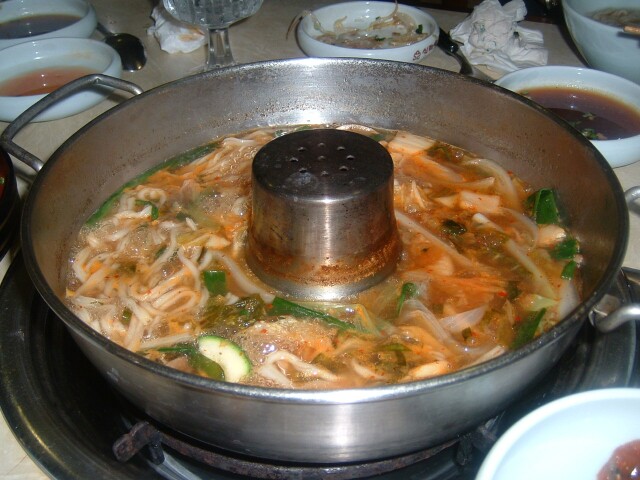
Finally, once the meat and vegetables are finished, the following are added to the broth: flat fettucine-shaped noodles, hot Nappa cabbage kimchi, green onions, sliced zucchini, and button mushrooms. The whole thing is overlayed with lashings of chili pepper and wild sesame powder. Drink up - I guess the idea at this point is to sweat out to make up for all the overeating you've just done.
-
People have often noted how holiday dinners in Hawai`i often end up being complex fusion experiences. At least in our case, however, almost, but not quite. . .
We had about 30 people over for Thanksgiving, mostly my mom and her friends, with some of the younger generation as well. It was more or less potluck and here's what we ate (not including dessert): turkey with "Cajun" (sic) spice rub, stuffing with pine nuts and shiitake, fresh cranberry sauce with white peaches, cheongpo mook (mung bean jelly with spicy sauce), tottori mook (acorn jelly with similarly spicy sauce), nappa cabbage kimchi, spicy doraji (bellflower root) salad, ae hobak namul (cold seasoned zucchini), naengchae (cold salad of egg strips, pear, carrot, and radish with mustard sauce), chap chae (stir-fried bean thread noodle with beef and vegetables), saengseon jeon (pan-fried egg-dipped fish), baked ham, green salad with dried cranberries and walnuts, corn, and rice.
So it was a typical Korean-American holiday meal. However, it's really easy in to divvy up this menu into American and Korean dishes; nothing really East-West fusion except for perhaps the stuffing and (a stretch) the cranberry sauce. The desserts were mostly pies and cakes; no Korean desserts unless you count fruit. The guests brought so many pies that it seemed as if each person could have their own individual pie, but that's another story. There was this article in the New York Times about how immigrants adapt the preparation of Thanksgiving turkey according to their ethnic heritage, but that doesn't really seem like what happens with us. It's more like the contemporary Korean wedding ceremony - Korean and Western patterns side-by-side, no attempt to mix them except for the fact that they are consumed at the same time.

Here is a lousy picture - much of the food is not visible - I was too self-conscious about taking pictures of the food to frame the shot better and take more pictures. But you can see the kind of alternating Korean-American-Korean-American pattern to the array. The foreground dish is the cheongpo mook, with the tottori mook in the large square bowl next to the ham. The zucchini namul is in the smaller square container, and the kimchee and doraji are next to the turkey.
Any multicultural tales of Thanksgiving or other holidays to tell?
-
Irwin, as usual you have saved us all. Never knew that stuff like pipi kaula and beef chow fun were made from hanger steak - little did we know we were consuming such a fashionable cut of beef! Interestingly enough, the recipes I have seen for pipi kaula (Hawaiian-style cured and dried beef) call for flank steak. Local beef is definitely still available here in the islands, including "luxury" beef previously shipped in from the mainland. Big Island beef is increasingly being supplemented by beef from grass-fed cattle raised on former pineapple and cane lands on other islands, including on Oahu by the North Shore Cattle Company. I totally agree with you about local pork. . .
Montrachet, it's interesting you mention your preference for kurobuta/Berkshire. Someone could write a book (or at least a Saveur article) about the history of this breed. Allegedly developed originally (according to dubious legend) by Oliver Cromwell between bouts with the royals, it was introduced into Japan from its native Britain over a century ago. In the last few generations, however, Berkshire had nearly disappeared from British and other Western markets and restaurants due to its expense (it tends to put on weight slowly) as well as (strangely enough) its relatively dark flesh, which many marketers felt turned off consumers looking for "the other white meat". However, it has remained a prized breed in Japan of all places, where production and consumption never dropped off, due to its unsurpassed flavor and marbling. Hence, almost all the Berkshire pork that was produced in the West was exported to Japan. Recently, with increasing demand for luxury meats, it is coming back into favor in the lands of its origin, particularly in high-end restaurants.
Kristin, thanks for the link to the liver sashimi thread. . .
Edited to remove foot-in-mouth.
-
Thanks, Kristin. Come to think of it, the sauces may have been associated with one of the cuts of meat that we ordered. Just can't remember which one it was!
montrachet, thanks so much for the clarification on the nakaochi. It sounds very much like the ordinary way in which ribs are prepared for kalbi in Korea, though in Korea they are butterflied and left attached to the bone as a kind of "flag". Wonder how the regular kalbi at Gyukaku is cut. . .
Have not seen hanger steak for sale here in Hawai`i but have not looked for it either. One of our posters is one of the state's preeminent meat purveyors - any comments Lym?
Finally, regarding wine bars, here's a short article from the Advertiser a few months ago. Here is a recent review for Little Vino.
-
Gyukaku Kapiolani Branch
1221 Kapiolani Blvd #105
Honolulu, HI 96814
808 589-2989
http://www.gyukaku.ne.jp/ (Japan)
Korean restaurants in Japan date back at least a century; many were set up to serve migrants from Japan's new colony during the early 20th Century. However, Japanese did not really eat Korean food in large quantities until the early 1980s or so, around the time it became popular in Japan to patronize ethnic (non-Western and non-Chinese) restaurants. From this period on, however, the popularity of Korean food has expanded at an amazingly rapid pace, and has over the past decade or in particular developed to the point where Korean-style restaurants are a feature of even small communities and kimchi can be found in all of your local convenience stores.
How and why did this happen? One clue to this can be found in the fact that the idea a “Korean meal” in Japan is associated almost entirely with eating grilled meat, particularly beef. Indeed, the Japanese word for grilled meat, yakiniku, is used in Japan almost synonymously to refer to Korean food。 Nearly every large Korean restaurant in Honolulu will display these characters 「焼肉」, 「焼き肉」, 「やきにく」 prominently on their windows, signs, and / or doors in order to attract Japanese tourists. It is of course true that kalbi, bulgogi, etc. are extremely popular as restaurant food in Korea, but they are simply one element of the cuisine, and not dominant by any means as they are in Japan.
Indeed, it's plausible to say that the phenomenal popularity of Korean food in Japan is in large part due to the role it has played in helping Japan to adapt its cuisine to the increased availability and consumption of meat, particularly beef. Korea has a long tradition of eating meat. In Japan, however, meat-eating was long a matter for customary and even legal prohibition, and occasional transgressions of such norms had to go other such euphemisms as "mountain whale". While this opposition is often attributed to Buddhist teachings, this would be puzzling in light of the fact that no other Buddhist country (including Korea) applied vegetarian strictures so strictly to commoners. Nor does it explain why the more plentiful fish were allowed.
At any rate, starting from the Meiji Era, when the post-Restoration leaders decided that Japan's diet must emulate that of the West and the Meiji emperor famously stated that "those who do not eat meat are not civilized", the amount of meat in the Japanese diet has steadily increased and prohibitions have evaporated. Until fairly recently, however, beef was an expensive commodity, and its consumption was lower than that of pork or chicken. This changed during the 1980s and 90s, when trade barriers against imported beef were gradually loosened in response to outside political pressure. These moves made large quantities of frozen, grillable cuts of beef from Australia, the U.S., and elsewhere available at a relatively reasonable price. However, there was no established culinary context in Japan for the integration of grilled beef into everyday eating.
Since the early 20th century, the niche for grilled beef in Japan had been filled primarily by steakhouses and by the "teppanyaki" restaurant concept, in which unmarinated steaks were grilled on a heated steel counter and served with Japanese-style sauces. And while teppanyaki has long been one of the most popular types of "Japanese" restaurants in the U.S. since being introduced here by "Rocky" Aoki through his Benihana chain in 1964. In Japan, however, teppanyaki was originally considered a kind of "Western" food, and has not featured the kind of knife-tossing hysteria introduced into American versions of teppanyaki by Aoki. Moreover, teppanyaki has always been an upscale experience based on luxury ingredients (if you don’t have steak, you might end up with lobster or king prawns) and was still basically Western in its meal construction (besides the large piece of meat, a few sauteed veggies), and thus could hardly be eaten on a regular basis.
The phenomenal spread of “Korean” yakiniku in Japan can thus be explained by a combination of characteristics that are complementary to the ongoing trends towards increased meat consumption and experimentation with ethnic foods. First, it provides beef in a culinary context (soy-based marinade, cut during preparation rather than on the plate, numerous side dishes and rice) that are easier to reconcile with typical Japanese preferences and eating habits than Western-style steak or even teppanyaki. Second, it can be made using varieties and cuts of meat that were not quite as luxurious as those needed for teppanyaki. Thus it can take advantage of imported frozen meat and can be eaten regularly at an affordable price. Finally it draws upon a long tradition of sophisticated beef cookery, and provides an eating experience that is both “ethnic” and familiar.
Gyukaku is a manifestation of the burgeoning popularity of Korean food. Boasting 800 branches throughout Japan, it is one of the great success stories of the Japanese mass-feeding industry. It is also a manifestation of the ways in which Korean food has been “domesticated” in Japan, turning it into something that would hardly be recognized as Korean in its home country. The differences between Gyukaku and a typical Korean-Korean bulgogi restaurant are numerous. The most notable thing about the presentation is that everything is ala carte, including rice, side dishes, and kimchi, and you are expected to pay for everything separately. This comes as culture shock to many Koreans who walk into Korean-Japanese restaurants and expect to have an assortment of panchan arrive for no charge as part of their order (this happens a lot in Waikiki).
Furthermore, the meat arrives in small portions (two to four portions are needed to feed one adult person, along with side dishes) and you are allowed a choice of marinades for each type of meat. In Korea, meat arrives in portions large enough to feed (at least in theory) one or more people, and the each type of meat has its own distinctive, fixed marinade. For instance, in Korea, pork bulgogi marinade is always prepared with chili bean paste, while beef bulgogi marinade never has any chili. At Gyukaku, there are four basic types of marinade: tare (soy sauce-based), miso, garlic, and salt-based, and for most types of meat you are allowed to mix-and -match the marinade that you prefer from some subset of these. The marinades themselves are different, quite a bit sweeter than any meat marinade you would encounter at a Korean-Korean restaurant.
The types and cuts of meat are different as well. Typical Korean beef cuts such as chadol baegi (side brisket) and jebi churi (chuck) that are one the chewier side do not seem popular in Japan, nor is rolled pork belly (fresh bacon) (samgyeopsal), the basis for the prototypical male-bonding meal in Korea. On the other hand, one cut of beef found in Gyukaku, harami (inside skirt of beef) seems to be distinctively Japanese, as are some of the other grilling alternatives such as kurobuta (Berkshire pork) sausage.
Enough of the long preamble; here is what we actually ate. There were three rounds of meat to our meal:
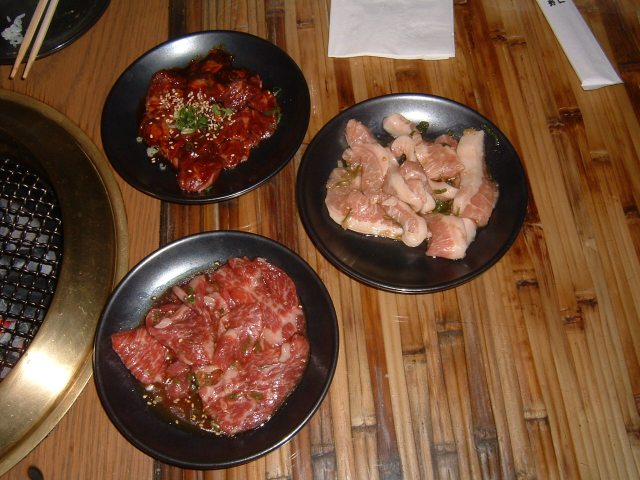
This consists of spicy miso-marinated nakaochi kalbi, “p-toro”, and tare-marinated harami.
One thing you can always depend on at Korean-Japanese restaurants is that the meat will always be tender, and the nakaochi kalbi is no exception. Now if I can just figure out what it means, lit. the characters are “middle-fall”. According to Japanese dictionaries, nakaochi refers to the middle bone on a fish when it is cut into three pieces, as well as the flesh clinging to it. So nakaochi kalbi must mean something like “center cut”. Not sure if this is really significant for the taste. But at any rate the bone would be larger than normal, if there was any bone, which there isn’t, another dependable feature of Korean-Japanese restaurants, even though kalbi means “rib”. The red miso is very sweet and only slightly hot.
P-toro is Gyukaku’s name for pork pieces from where, I’m not sure. “Toro” is the term for tuna belly (another fish analogy!) and “P” apparently stands for “pig”. So cute! However, this doesn’t look like pork bellies – not fatty enough. It comes with plain salt-based marinade.
The harami (fajita) is only slightly chewier than the kalbi cuts. Can’t remember what I thought about the marinade.
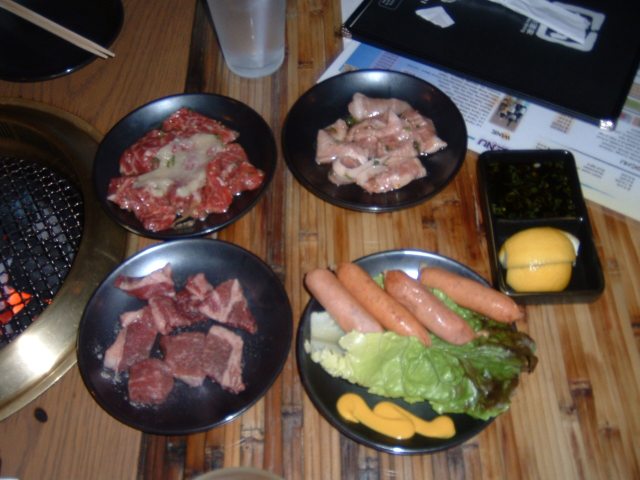
(top-left clockwise) garlic kalbi, more p-toro, kurobuta sausage, rosu.
The garlic seems to be placed on top of the kalbi rather than used as a marinade. While there is quite a bit of it, it looks to have been rendered innocuous by some sort of pre-cooking process. This is regular kalbi, not nakaochi.
The kurobuta (lit.“black pig”, i.e. Berkshire) sausage looks disturbingly like the stuff that you find in Japanese supermarkets in little tube-like containers. However, it turns out to be a tiny but good-quality cured sausage with noticeable smoke flavor. Even the mustard has a reasonable kick and has a bit of vinegar in it, Western-style.
Rosu (lit. “roast”) is little square pieces of unmarinated beef. This perhaps the only area of yakiniku where Japan seems to have actually exported ideas back to Korea, where rosu gui has become a popular grilling option.
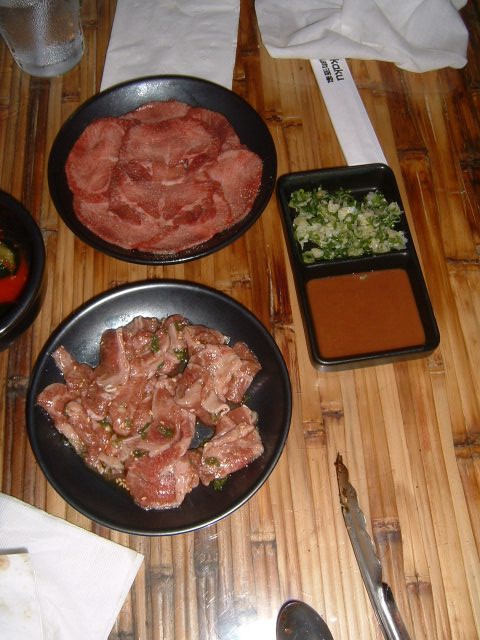
beef tongue, tare kalbi
Tongue (gyuutan) is a popular item on the yakiniku grill in both Japan and Korea. No marinade but it’s possible to get it with green onions (negi-tan.
We got more kalbi, with the regular soy-based marinade. . .
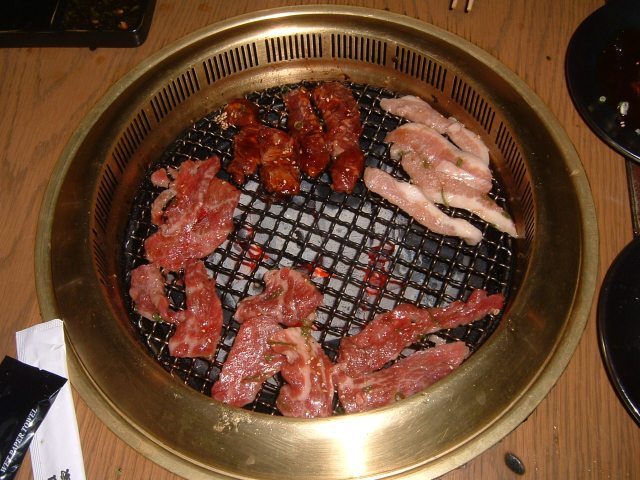
You cook over live charcoal. The setup here has a round, square-mesh screen covering a relatively small, recessed firebox build into the table. The mesh is small enough so that you don’t have to worry about anything falling into the fire.
The vertical slats are apparently some kind of ventilation system built into the grill. The overhead smoke ventilation fans here are very unobstrusive, and very little smoke comes out of this grill anyway.
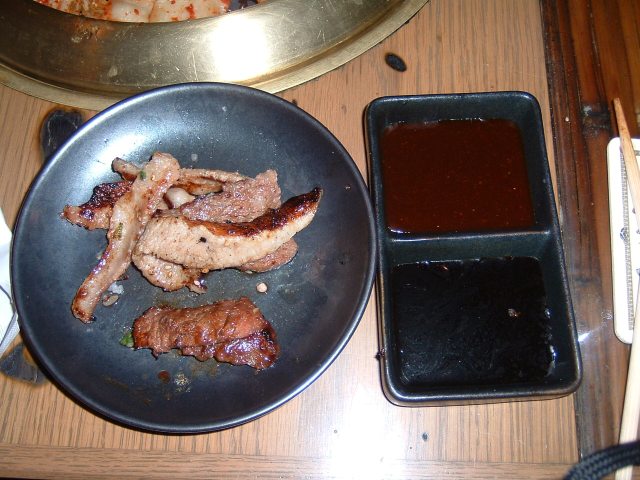
The cooked meat here comes with two kinds of sauces, a ponzu (soy citrus) sauce and a rather sweet sauce bordering on tonkatsu sauce.

As mentioned, you have to order the kimchi separately. We finally gave in after getting overloaded on meat and a tiny bit of rice. The scandalous fact that you have to pay for it aside, the kimchi is not as "kimuchi"-ish as you would expect. It is a closer to Korean kimchi than sweet n’ sour the kind you find in Japanese supermarkets and convenience stores.
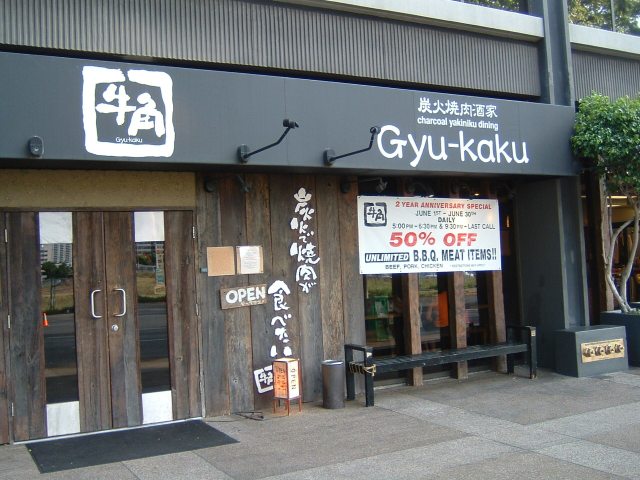
The Kapiolani branch of Gyukaku is on the first floor of an office building on the makai-Ewa side of the corner of Kapiolani and Pi`ikoi that seems to house mostly dentists. There’s a small validated parking lot, or you can try chance the street parking. There’s another branch in Waikiki, three in L.A. and the remaining 800 or in Japan. None in Korea as of yet, though that wouldn’t surprise me – they would just have to bill themselves as a “Japanese restaurant”.
-
Kristin - you're more than welcome. I really think UH should be thinking seriously about opening up a small "satellite" branch in Japan but that's another issue. . .
Rachel, the "Ba-Le" you went to in Austin was probably a copycat restaurant and not an official franchise! As far as I know the official Ba-Le franchises are restricted to Hawai`i, though there may be a few that are unofficially affilitated and run by relatives on the West Coast. But the fact that someone in Texas is copying the Ba-Le name shows that the chain has really achieved a high level of visibility. . .
-
KC Drive Inn
1029 Kapahulu Avenue
808 737-5581

Yet another local-style bento, from the soon-to-be lamented KC Drive-In on Kapahulu Ave. This is their "alternative" mixed bento without teri beef or spam. Just shoyu chicken and fried mahimahi, along with the portuguese sausage, kamaboko, and furikake on top the rice.
-
University of Hawai`i at Manoa Dining Service
http://www.hawaii.edu/campuscenter/Vendors/
Like many institutions of higher education, the University of Hawai`i's main campus has for several years leased the rights to stuff food down the mouths of its 20-some odd thousand students to Sodexho, the French giant that dominates much of the world's institutional food service business. This contract was inherited from Marriott Host, which had itself held the contract for several years, when the Host was swallowed whole by Sodexho. Despite what some purveyours of crude national stereotypes may think, moving from being Utah-owned to French-owned did not lead to an instant transformation in the quality of food, and over recent years the complaints have continued to pile up. Of course, griping about campus food service is just a normal part of the college experience, but at UH the complaints had a special poignancy - the food was simply not "local" enough. It was generic mainland food being plied onto them by a European-owned company, and didn't reflect the Pacific and Asian roots of much of the student population.
To give credit to the management, they had gone out of their way in recent year in attempting to address these complaints, installing such things as a select-your-own-stir-fry station, a saimin (soup noodle) stall, and even a loco-moco (meat and egg on rice) bar at the various campus dining locations, as well as providing packaged assortments of sushi, manapua (local-style dimsum), and spam musubi (you don't want to know). Nonetheless, many students continued to feel that the versions of the dishes supplied were not up to par with what they were used to getting from outside restaurants and plate lunch places, and while business improved, it still failed to take off.
Last year, the management even experimented with setting up a demonstration station specializing in Hawaiian Regional Cuisine, offering up such dishes as tataki-style seared rare ahi, furikake-crusted mahimahi, and garlic-teriyaki marinated ribeye. However, this was a commercial failure. While the prices for these dishes was relatively cheap, generally under $10, it was still more than the average college student was willing or able to pay for a school cafeteria lunch.
Starting from this August, seemingly in desperation, the management finally crossed the Rubicon. Sodexho essentially subcontracted most of the campus dining facilities to two local companies: Ba-le and PBHK Inc. Ba-le is a fast food franchise operation specializing in banh mi, Vietnamese-style baguette sandwiches. PBHK is the parent company for Yummy's, a chain specializing in Korean-style plate lunches. Ba-le and Yummy's are the third and fourth largest restaurant chains in the state (after L&L and Zippy's). Ba-le is the second-largest Vietnamese restaurant chain in the world (after Pho Hoa), and Yummy's is the largest Korean restaurant chain in the U.S.
That this is an act of desperation is indicated by the fact that Sodexho is not in a good position regardless of whether the experiment works or not. If it fails, then it will be blamed. If it succeeds, then the University management could presumably decide to contract directly with the vendors themselves.
PBHK has essentially taken over the Campus Center Dining Hall, the largest eating facility on campus, while Ba-le has taken over what used to be called Manoa Gardens, an annex of sorts for the Campus Center, located between it and the undergraduate library. The third major dining facility, the Paradise Palms Cafe, remains largely unchanged and continues to be run directly by Sodexho, except for a Chinese-style takeout line has opened up (run by whom, I'm not sure).
So what's it like? I'll start with Ba-le. As a full-service operation, the campus Ba-le couldn't very well serve only banh mi, so instead it has three different food stations as well as an assortment of packaged foods. Two of the stations offer an assortment of banh mi and pho, respectively, while the third offers Vietnamese-style curries and stews. There are a variety of ready-made salads and summer rolls on an island in the center. Bubble tea and Vietnamese-style ice coffee are available, as are an assortment of tapioca desserts. If you're desperate to avoid Vietnamese cuisine, you can still call through a small winodw and have the chef rustle up you some chicken fingers, onion rings and other fried 'Freedom Food'.
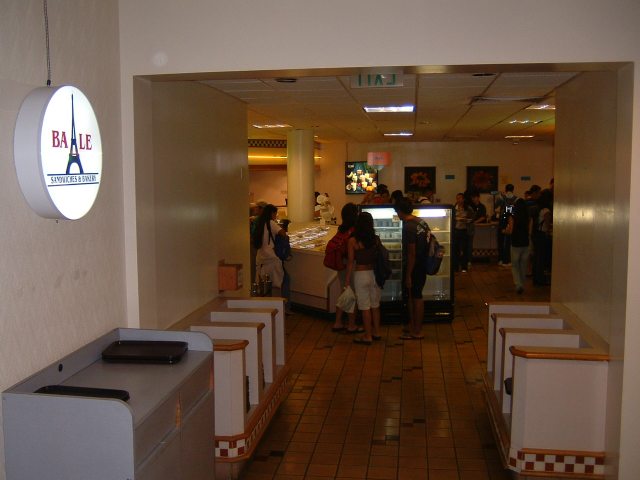
While the menu is greatly expanded from that of the usual Ba-le, it's not as much of a stretch at it might seem at first glance, since a few of the other Ba-le franchises, such as the one in Manoa Marketplace, also offer expanded menus, though without the chicken fingers. However, the nature of the facilities and the need for mass feedings during the lunch hour mean that the format is somewhat different. The entrance continues to be like that of the typical university cafeteria, rather than a restaurant, with first thing you see not being a chirpy greeter but rather stacks upon stacks of plastic trays arrayed low to the ground.
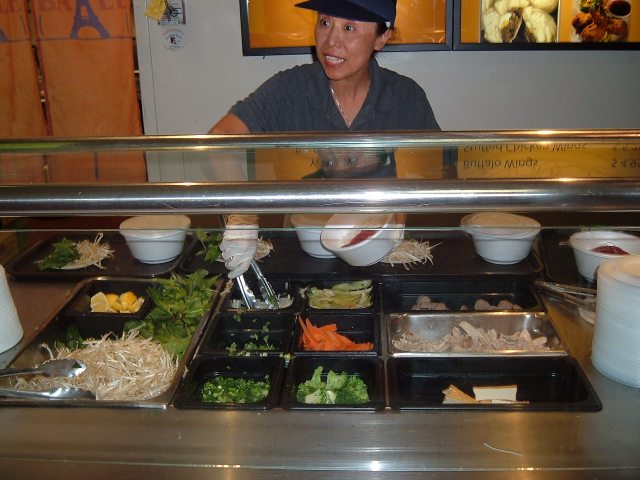
At the pho station, however, things are somewhat interesting. The need to prepare the pho quickly leads to a setup that is in some ways a strangely updated version of the what one might see in the birthplace of pho, the street stalls of Hanoi. The lady (sorry for cutting off her head) preparing the pho stands in front of a large array of veggies and two kinds of precooked meat, beef balls and chicken. For safety reasons, the raw beef strips are kept in a small refrigerated compartment behind the fixin' setup. The rice noodles are separate little piles and are quickly boiled to order in a colander-like instrument, while the broth stands in a huge pot on a burner next to the boiling water for the noodles. Things get really hectic during the rush hour, but the pho lady has already worked out a system for boiling one person's noodles while putting the garnishes on the next persons'.
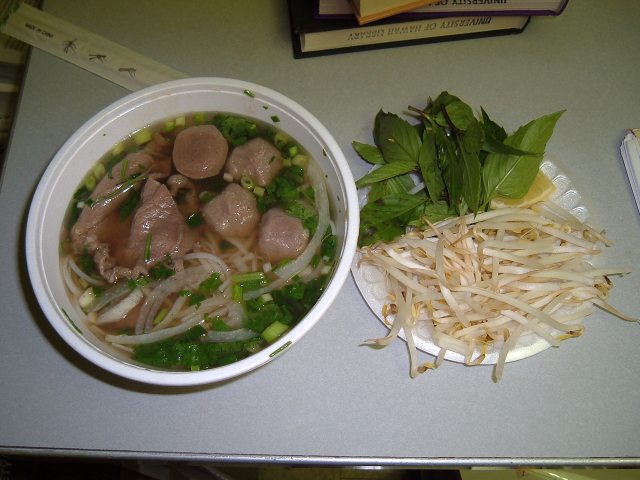
The pho itself is served in styro bowls similar to the kind associated with instant ramen. There are piles of plastic lids at the utensil station you can place on top of the bowls so that you can take it back to your office. The veggies (mung bean sprouts and basil) and lemon are on the side - you have to wrap it in aluminum foil if you want to take them out separately.
By the time you get back to your office, the raw beef is completely well done. Well, that's your fault for being so stuck to your desk and computer. The broth is O.K., with the requisite star anise and fish sauce flavors, though perhaps, in my opinion, it could be more concentrated in both the meat flavor and the seasonings. But you can't complain - it's a reasonably healthy alternative that wasn't available before; now you have no excuse for always larding up on food-service grinds.
The banh mi gets prepared at a sandwich station with similar trays full of different fillings. The main innovations are that there are a larger variety of breads - in addition to the usual baguette and croissant, you can also get your banh mi in ciabatta or whole-grain loaves. All are baked at the central Ba-Le bakery in Palama, which is to say that they are baked that morning and are of decent quality - none of the squishy stuff. The fillings are the usual ham, pate, fried tofu, lemongrass chicken, and veggies only, as well as roast beef, turkey, tuna, and even pastrami for those who wanted to be at Subway's (which, ironically, has opened up just around the corner). I've never seen anybody actually order the latter four, so I'm not even sure they're even necessary. The garnishes are carrot-and-daikon pickle, cucumber, and cilantro, just like Ba-Le sandwiches anywhere else. This is the lemongrass chicken banh mi, though it's hard to see it through all the garnishes. . .

I was interested in trying the Vietnamese-style curry, since it's not a common dish even at most sit-down Vietnamese restaurants here, and is an interesting solution to the problem of how to offer a "hot meal" alternative to pho and sandwiches without using up excessive labor.
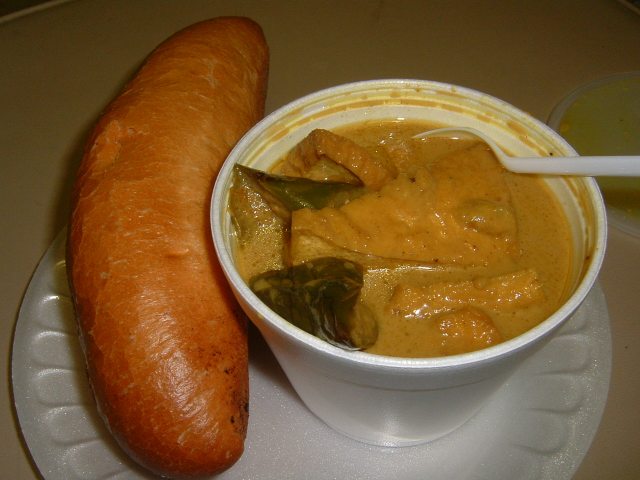
You can have your curry with rice on the side, or Saigon-style, with a baguette. There are two kinds - chicken or the one pictured, eggplant and tofu. They do not skimp on the coconut milk for this curry - there is a lot of it, seasoned with a fenugreek n' turmeric laden Vietnamese-style curry powder. I like eating it with the baguette - it soaks up the sauce much easier than the rice.
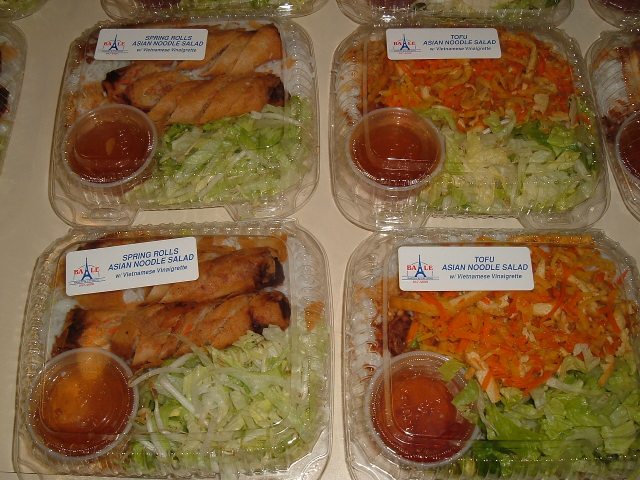
The ready-made foods include an assortment of summer rolls (pork, shrimp, or even tuna); rice noodle salads topped with lemon grass chicken, spring rolls, or fried tofu; beef or lemon grass chicken lettuce salad, and green papaya salad. Of course, don't expect the spring rolls to be super-crisp, but otherwise there is a surprisingly large assortment to choose from.
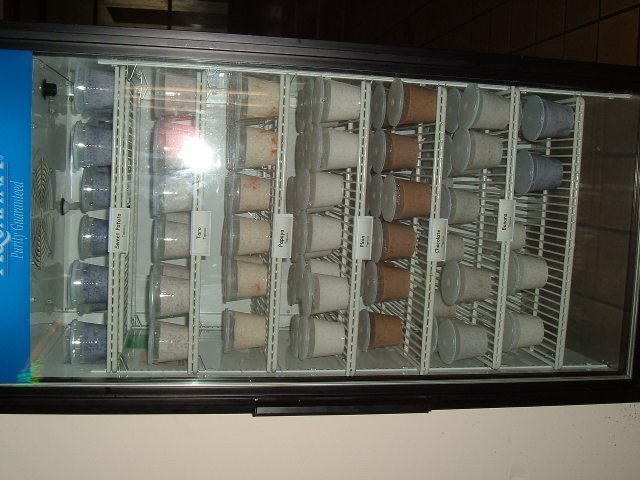
Here's the tapioca tank. A food service first!
We'll get to the Campus Center when I have time. . .
-
Nice posts on Onokinegrinz, Reid. They come so fast and furious I gotta check every couple days to keep up!
I haven't been able to Yotteko-ya yet, but your blogfriend is right, the broth is definitely more Hakata-style alright with the cloudiness and the boiling for ten hours "high collagen" stuff. Hakata is in Kyushu and is nowhere near Kyoto. There really isn't any well-known Kyoto style that I'm aware of, though there is a Kansai (greater Kyoto-Osaka area) style that is usually distinguished by use of salt instead of shoyu or miso. However, it's not usually boiled as long or as vigorously as what you got at Yotteko-ya.
-
Montrachet - thanks for joining us. It was definitely not Basmati Rice they are using - I don't think Thai Jasmine either; it actually seems to be japonica-style medium grain! However, Basmati would probably not be authentic anyway for lemon rice, since it is a South Indian dish and Basmati is not grown in the South. The Tamils would probably use their "red" partially converted rice, which is not available in N. America as far as I know.
Reid - I'm not sure if I got a different kind of batch than you, but the Nasi Lemak that I ate there had a very strong coconut taste albeit not that much pandan (which at least to me is probably a good thing for a savory dish). The owners of India Cafe are from Malaysia originally, of Tamil extraction.
Interesting that you got the same kind of noodles! I think I'm going to have it with Spam because Spam goes with everything.
-
Thanks for the input, Reid. As far as my own taste goes, it's fine. Not sure how it was before because I just started going there about a year ago.
Also like the way that India Cafe prepare their nasi lemak, but it could be a matter of taste. What is it that you don't like about it?
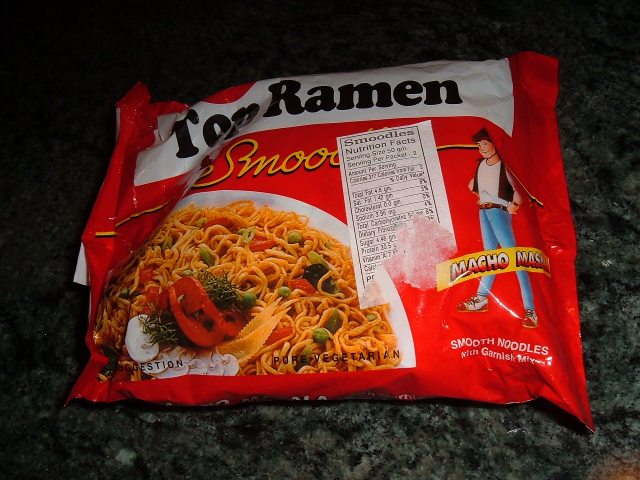
BTW, here is the picture of the Macho Masala Top Ramen I was talking about. Does anyone know what you would serve with it?
-
Komala Curry House
700 Bishop St. (Amfac Center) and
1111 Bishop St.
Honolulu, HI 96813
808 523-9900.
Honolulu doesn't enjoy a plethora of South Indian places, but ones that it has, while modest, are all fairly good.
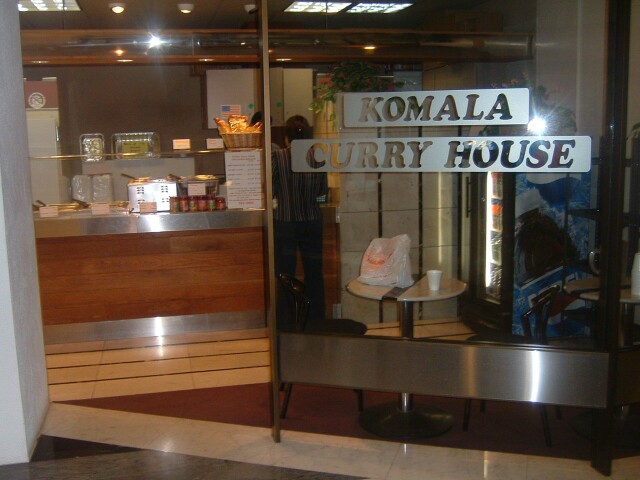
The Komala Curry House has two small locations around downtown, both inside of larger buildings. Unlike India Café, the Komala Curry House is not Malaysian-inspired "restaurant food", but rather presents a representative sample of Tamil home cooking from the various communities of Chennai (formerly known as Madras), as well as a few Northern dishes and "local-style" adaptations. This means not so much idli and dosai, but a phethora of curries, dahls, poriyals, and rice dishes, all doled out cafeteria-style for hungry downtown salarypeople.
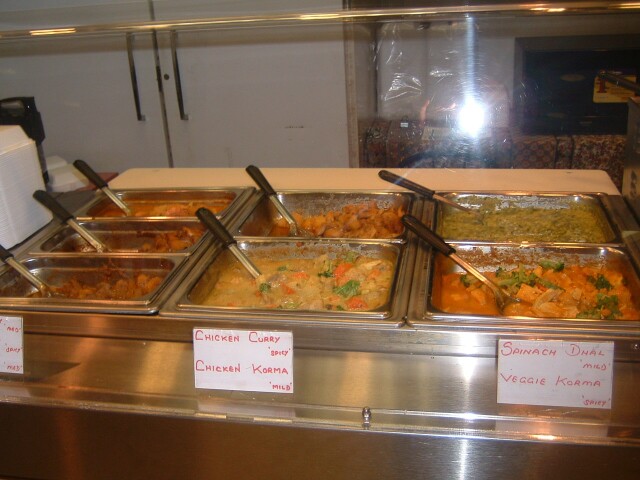
The exact rundown of food on the steam trays varies from day to day, depending on the inclinations of the owner. One thing that is almost always there is their lemon rice, which is the standard starch item that you get with your "regular" (one non-veg and one veg) and "mini" (one veg or non-veg) plates. And as my Tamil-raised-in-Mumbai-suffering-in-Honolulu friend Raja points out, it is real lemon rice, not just a yellow-colored pilaf.
You will always see trays with non-descript titles such as "Lamb Curry" and "Chicken Curry". I don't know if the dishes have more specific names, and nothing is distinctively Southern about the recipes, but at any rate while they are well-made. They also serve a "Chicken Korma" which looks like it may have some coconut milk in it (though usually the Southern versions are spelled "kurma"), but I haven't tried it yet.
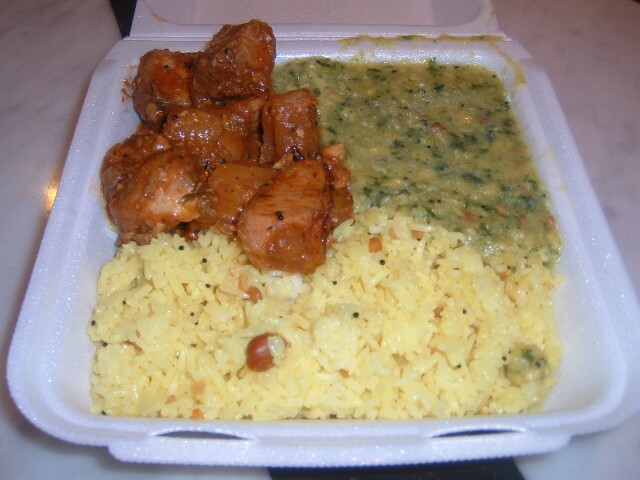
One distinctive southern dish that often shows up on the trays is Fish Kozhambu. Kozhambu is a preparation from central Tamil Nadu with a sauce containing garlic, fennel, fenugreek, and curry leaves, along with sometimes pounded coconut. Here it is in a "regular" plate with some lemon rice and a spinach dahl - the latter which seems more Punjabi than Tamil but what do I know.
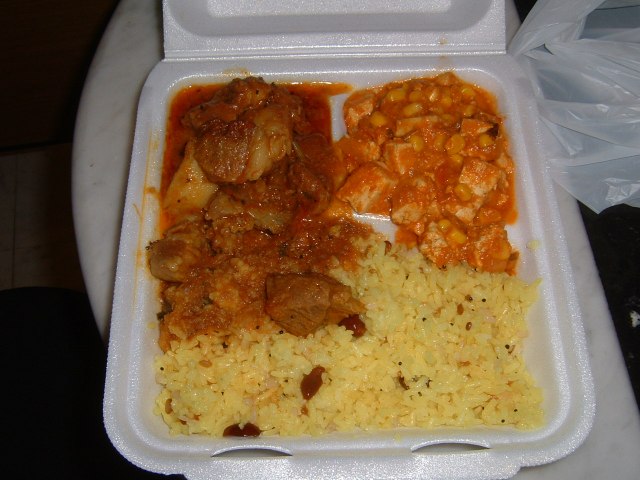
Perhaps their trademark local-style adaptation is their "spicy tofu", a stir-fry that features, as advertised, a sauce containing a large amount of chiles, complemented by garlic, ginger, and (I'm guessing wildly here) some cumin and curry leaves. Here it is on a "regular" of it along with the "lamb curry" and lemon rice.
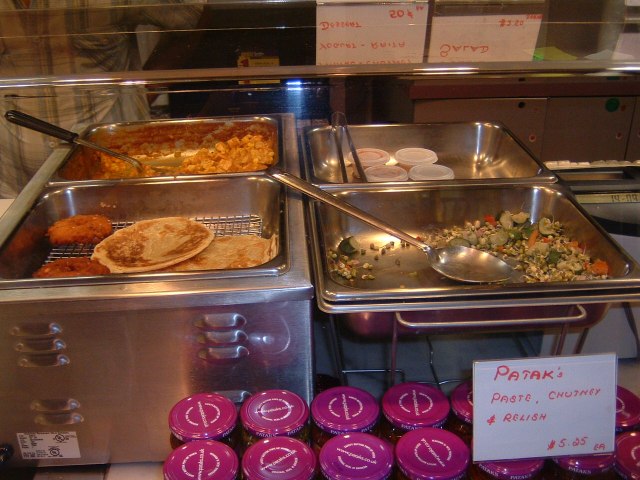
Komala also occasionally has samosas and / or paratha. It also sells a small variety of packaged items such as Patak's marinades and chutneys, various forms of packaged chaat (savory snacks), and an interesting "Macho Masala" Nissin Top Ramen that is marketed only in India. I bought a packet, but I'm kind of afraid to try it.
-
If you have time while you're here, would be nice to meet. The most efficient way to get people together from the board seems to be to start a thread shortly before you arive suggesting a get-together with locations and approx. times you're available.

Mom's in Hawaii, what should she bring me?
in Hawaii: Cooking & Baking
Posted
Rachel - li hing mui is dried salted Chinese plum-apricot, a variety of what we call "crack seed" here (see schpiel below). Let me second a lot of the previous recommendations - here are a few more additions, elaborations, and weird thoughts on the many useful suggestions that the others have made in earlier posts:
In this age of rampant globalization, just about anything that is nonperishable and can be carried from one part of the world to another is available just about everywhere in the industrialized world, if not in specialty stores, then on the web. It make the business of seeking out local specialties and carrying them home a lot less romantic than it used to be. That being said, there are a number of distinctive local Hawai`i products that are portable and survive long plane flights, yet relatively hard to get elsewhere. So it might be worthwhile having your parents lug back some of the following:
Pure Kona coffee is certainly one of our best-known products, though you can buy it from many reputable specialty roasters on the mainland (as long as you're careful to specify 100% Kona instead of Kona Blend, which usually has on 10% Kona beans). One the other hand, one thing that is difficult to get on the mainland is single plantation-grown estate Kona coffees. These are beans that express the flavor of a single growing area and are registered to ensure that they are never blended. If your parents happen to be passing through the South Kona Coast, most of these are available from the plantations where they are grown, as well as local shops. A list of estate coffees can be found on the Kona Coffee Council website.
Local and traditional herbal tisanes are an excellent gift, as laniloa mentioned. The more popular ones include those made with mamaki (pipturus albidus) leaves, `ohelo (vaccinium reticulatum) berry, and ko`oko`olau (bidens amplectens). Not mention awa aka kava, which will give you a mild buzz, and noni, which is credited with all sorts of antioxidant qualities.
`Alaea (or more precisely pa`akai `alaea), rock salt mixed with red earth, is available from a wide variety of specialty retailers. However, be careful to avoid the ultimate globalization trick - be sure that you are getting `alaea made from locally collected rock salt and not rock salt that is imported from California and sold to tourists as Hawaiian. We had a thread about `alaea a while ago.
One local specialty that you're unlikely to find even at specialty food stores on the mainland is crack seed, the spiced preserved fruits that were originally from southern China but were later transformed into a local obsession. Thrill your friends with lip-puckeringly salty and sour li hing mui or mango seed. If they're in Honolulu, one convenient place to get it is at the Crack Seed Centers in Ala Moana. The fact that they have a website shows that even crack seed is not immune to the e-commerce trend, but it is still cheaper to get it locally. If you want to go somewhere even more out of the way, most neighborhoods have their own local crack seed stores. Waiola Shave Ice also carry a pretty good selection. Here is a link to an excellent article Rachel Laudan (caroline) wrote about them.
Local jams and jellies are a good bet. Particularly poha jam, made from the island gooseberry, which is widely available in local supermarkets. Poha jam has a kind of seedy tartness that is pretty addictive. Guava and lilikoi (passion fruit) jams and jellies are even more widely available, though not as special.
Yes, cookies are not unique to Hawai`i, but local-style cookies are really unique. Among other things, they are really small and come in very interesting flavors, but not so weird that the relatives will reject them if your parents bring some home. Here is a thread on local cookies, with a link to an obsessive essay I wrote about them.
If you are looking for the only-in-Hawai`i, somewhat bizarre, souvenir food products, here are a few possibilities:
Hurricane Mix: This is packaged popcorn with arare (rice crackers) and furikake (seasoned dried seaweed flakes). Somehow this has become a fad snack locally over the last few years. A very strange East-West blend.
Li Hing Gummy Worms: Another hard-to-explain local fad. This takes the sour anise-laden powder used to season li hing mui (see above) and sprinkles it on gummy worms. Enjoy!
Commemorative Musubi Spam: The love of Spam in Hawai`i is so deep and so true that a while ago the Hormel company released an incredibly kitchy special commemorative can featuring hula dancer dolls and the local favorite: Spam musubi. I posted a picture on the a previous thread. Anyway, there may be a few left on the shelves.
Canned Wahoo (ono): This has become a cult product - formerly available only in Samoa, now available on Oahu as well. Sort of like canned tuna but a lot better. Lee Cataluna of the Honolulu Advertiser has been spreading the religion about it; here is an article by her and here is another.
All of the last few products are fairly widely available at local grocery stores in Honolulu. Finally, although they were probably the single most popular consumable souvenirs from Hawai`i up until the early 1980s, I would not recommend that your parents try to get their hands on any "Kona Gold" or "Maui Wowie".